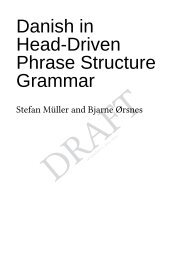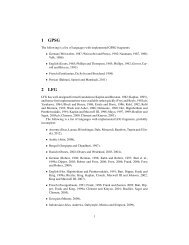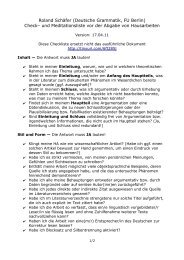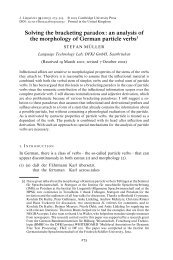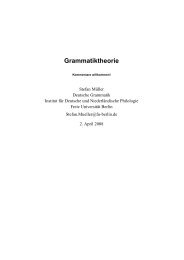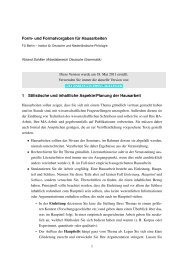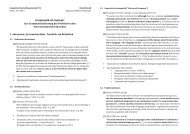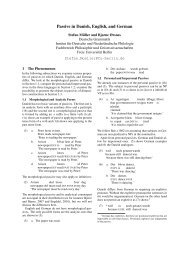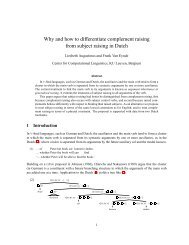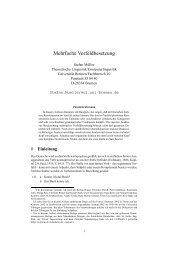Nonverbal Predicates in Modern Hebrew - German Grammar Group ...
Nonverbal Predicates in Modern Hebrew - German Grammar Group ...
Nonverbal Predicates in Modern Hebrew - German Grammar Group ...
You also want an ePaper? Increase the reach of your titles
YUMPU automatically turns print PDFs into web optimized ePapers that Google loves.
<strong>Nonverbal</strong> <strong>Predicates</strong> <strong>in</strong> <strong>Modern</strong> <strong>Hebrew</strong><br />
Petter Haugereid 1,2,3 , Nurit Melnik 2 and Shuly W<strong>in</strong>tner 3<br />
1 Department of L<strong>in</strong>guistic, Literary and Aesthetic Studies, University of Bergen, Norway<br />
2 Department of Literature, Language and the Arts, The Open University of Israel, Israel<br />
3 Department of Computer Science, University of Haifa, Israel<br />
1 Introduction<br />
<strong>Nonverbal</strong> predicates <strong>in</strong> <strong>Modern</strong> <strong>Hebrew</strong> (MH) have been the subject of <strong>in</strong>vestigation <strong>in</strong> a number of<br />
studies (e.g., Doron 1983; Falk 2004). However, to our knowledge, none of the exist<strong>in</strong>g studies was<br />
corpus-based. We show that an empirical exam<strong>in</strong>ation of this phenomenon reveals patterns which have<br />
not been previously considered yet which should be taken <strong>in</strong>to account when propos<strong>in</strong>g a comprehensive<br />
analysis. Our analysis <strong>in</strong>deed accounts for all these patterns, unify<strong>in</strong>g the treatment of three types of<br />
copular constructions that we identify <strong>in</strong> MH. The analysis is implemented as part of a larger-scale<br />
grammar, and is extensively tested.<br />
The standard data items which appear <strong>in</strong> the literature regard<strong>in</strong>g the constructions are the follow<strong>in</strong>g:<br />
(1) dani (hu) more<br />
dani (he) teacher.SM<br />
‘Dani is a teacher.’<br />
(2) dani (hu) nexmad<br />
dani (he) nice.SM<br />
‘Dani is nice.’<br />
(3) ha-yeladim<br />
the-kids<br />
(hem) al ha-gag<br />
(they) on the-roof<br />
‘The kids are on the roof.’<br />
Here, the predicates consist of NPs (1), AdjPs (2), and PPs (3). The copula l<strong>in</strong>k<strong>in</strong>g the subject and the<br />
predicate is homophonous with the 3rd person pronoun (hence the gloss) and agrees with the subject.<br />
These forms of the copula are only used <strong>in</strong> present tense, and they are sometimes optional. In past and<br />
future tense an <strong>in</strong>flected form of the verb haya ‘be’ is obligatorily used. The present tense form of haya<br />
is miss<strong>in</strong>g from the MH <strong>in</strong>flectional paradigm.<br />
(4) d<strong>in</strong>a hayta/tihiye mora/nexmada<br />
d<strong>in</strong>a was.3SF/will.be.3SF teacher.SF/nice.SF<br />
‘D<strong>in</strong>a was/will be a teacher/nice.’<br />
The examples above constitute the prototypical examples of the copular construction. In the majority<br />
of the papers which address this construction (<strong>in</strong> MH as well as <strong>in</strong> other languages), the subject <strong>in</strong> the<br />
data items is an animate NP. Less frequent subjects are concrete nouns (e.g., The books are on the table.).<br />
Yet it is particularly rare to f<strong>in</strong>d abstract nouns as subjects. Nevertheless, corpus searches 1 reveal that<br />
abstract nouns are <strong>in</strong> fact more frequent, and, perhaps more importantly, exhibit additional properties<br />
which are often overlooked when only animate nouns are exam<strong>in</strong>ed.<br />
One such property <strong>in</strong>volves agreement. While AdjP predicates obligatorily agree with the subject<br />
((2) and (4)), the agreement relationship between subjects and NP predicates is more complex. Animate<br />
nouns are <strong>in</strong>flected for natural gender and number. Inanimate and abstract nouns have grammatical<br />
gender. When subjects and nom<strong>in</strong><strong>in</strong>al predicates <strong>in</strong> the copular construction are animate they agree <strong>in</strong><br />
1 In this study we use a 60-million token WaCky corpus of <strong>Hebrew</strong> (Baroni et al. 2009).
number and gender ((1) and (4)). Although it seems like a subject-predicate agreement relationship<br />
mandated by the grammar, this constra<strong>in</strong>t only holds when the nom<strong>in</strong>al predicate has natural gender.<br />
Nom<strong>in</strong>als with grammatical gender do not <strong>in</strong>flect and consequently agreement mismatches such as those<br />
<strong>in</strong> (5) occur.<br />
(5) ha-sefer hu matana<br />
the-book.SM he gift.SF<br />
‘The book is a gift.’<br />
In addition to the often discussed NP, AdjP, and PP predicates, two additional types of predicates<br />
are revealed, when one considers subjects that are realized as abstract nouns: <strong>in</strong>f<strong>in</strong>itival VPs and f<strong>in</strong>ite<br />
clauses. These are illustrated <strong>in</strong> (6).<br />
(6) ha-matara hi lehenot / she-dani yehene.<br />
the-goal.3SF she to.enjoy / that-dani will.enjoy<br />
‘The goal is to have fun / that Dani will have fun.’<br />
These types of predicates are absent from the literature on copular constructions <strong>in</strong> MH, yet seem to<br />
belong to the same category as the more prototypical constructions above.<br />
To summarize, the apparent optionality of the copula and its categorial identity, the types of predicates<br />
<strong>in</strong>volved, and the different agreement patterns are all issues which need to be addressed when<br />
propos<strong>in</strong>g an account of the data.<br />
2 <strong>Nonverbal</strong> Constructions <strong>in</strong> HPSG<br />
<strong>Nonverbal</strong> predicates are not prototypical select<strong>in</strong>g predicates. Phrases that can function as nonverbal<br />
predicates can also appear as subjects or complements of f<strong>in</strong>ite verbs. This raises the question of whether<br />
there are any differences between these phrases <strong>in</strong> their predicational vs. non-predicational function.<br />
The ‘canonical’ HPSG analysis of nonverbal predicates <strong>in</strong>volves a lexical rule which takes as <strong>in</strong>put a<br />
‘regular’ noun lexeme and outputs a predicative noun (Pollard & Sag 1994; G<strong>in</strong>zburg & Sag 2000). The<br />
predicative noun is marked as such by the b<strong>in</strong>ary feature PRD, its semantic content shifts from scopeobj<br />
to psoa, and it selects for an NP subject, thus creat<strong>in</strong>g a l<strong>in</strong>k between it and the clausal subject. The<br />
requirement <strong>in</strong> English for a f<strong>in</strong>ite verb to form a clause is fulfilled <strong>in</strong> this case by a f<strong>in</strong>ite form of the<br />
copula be, which comb<strong>in</strong>es with its predicative complement to form a VP. As a subject rais<strong>in</strong>g predicate,<br />
the copula structure-shares the subject requirement of its predicative complement, and comb<strong>in</strong>es with<br />
the subject to form a clause. Importantly, <strong>in</strong> this analysis the copula is semantically vacuous.<br />
The motivation for identify<strong>in</strong>g predicational phrases as such extends beyond the copular construction,<br />
s<strong>in</strong>ce the same class of predicates have a similar distribution (Pollard & Sag 1987:66). Nevertheless,<br />
when more data and other languages are considered the analysis faces some problems. Van Eynde<br />
(2008) raises a number of arguments aga<strong>in</strong>st the lexical rule analysis. He objects to the systematic ambiguity<br />
which the noun rule <strong>in</strong>troduces and provides evidence aga<strong>in</strong>st the identification of the subject of<br />
the copula with the subject of the predicate.<br />
Van Eynde (2008; 2009; 2012) shifts the burden from the predicate to the copula. Accord<strong>in</strong>g to his<br />
analysis, the copula is not devoid of semantic content. Rather, the semantic l<strong>in</strong>k between the subject and<br />
the predicate is captured <strong>in</strong> the lexical entry of the copula.<br />
While Van Eynde places the burden of the licens<strong>in</strong>g of the construction on the copula, MH as well<br />
as other languages allow its omission <strong>in</strong> certa<strong>in</strong> contexts. Although Van Eynde (2009:368) argues that<br />
this “is not by itself an argument for semantic vacuity” the (sometimes optional) omission of a copula is<br />
a challenge to an analysis <strong>in</strong> any framework. In the HPSG framework phonologically empty elements<br />
2
are generally avoided. Nevertheless, several accounts of copular constructions <strong>in</strong> a variety of languages<br />
do assume empty elements.<br />
Bender (2001) proposes a “silent verb analysis” to account for copula absence <strong>in</strong> African American<br />
Vernacular English (AAVE). Her crucial argument is based on complement extraction. When the predicative<br />
phrase is extracted <strong>in</strong> copula-less clauses (e.g., Where your car?) there needs to be a place to<br />
register the extraction site. This, she argues, can be done either by re<strong>in</strong>troduc<strong>in</strong>g traces or by the use of<br />
a silent copula. Both solutions require the stipulation of phonologically empty elements.<br />
Müller (2002; 2004) argues that <strong>in</strong> certa<strong>in</strong> constructions the use of empty elements is advantageous.<br />
One such case is the omission of the copula <strong>in</strong> declarative sentences <strong>in</strong> <strong>German</strong>, where assum<strong>in</strong>g a<br />
phonologically empty copula preserves the topological fields. Moreover, he demonstrates that the avoidance<br />
of empty elements may lead to the stipulation of additional rules and schemata, as well as a l<strong>in</strong>guistically<br />
less <strong>in</strong>sightful grammar.<br />
F<strong>in</strong>ally, the agreement relationship between subjects and predicates is shown by Van Eynde (2012)<br />
to be neither CONCORD agreement nor INDEX agreement, <strong>in</strong> the sense of Kathol (1999) and Wechsler<br />
& Zlatić (2003). Instead of hav<strong>in</strong>g predicates structure-share their CONCORD properties with the IN-<br />
DEX features of their subject, he proposes that their INDEX features be matched. When predicates have<br />
identical CONCORD and INDEX features, INDEX agreement between them and their subjects is reflected<br />
morphologically (e.g., adjective agreement <strong>in</strong> (1) and (4)). When predicates are underspecified for IN-<br />
DEX agreement features they structure-share those features with their subject, while their morphological<br />
agreement properties can either match or mismatch those of the subject.<br />
3 Our Analysis<br />
Three types of constructions with nonverbal predicates are identified for MH: the present tense construction,<br />
with and without a copula, and the past/future construction with <strong>in</strong>flected haya ‘be’. Our analysis<br />
accounts for the commonalities as well as the dist<strong>in</strong>ct properties of each construction by propos<strong>in</strong>g the<br />
type hierarchy <strong>in</strong> Figure 1.<br />
The type cop-sign subsumes all copula signs and specifies their valence requirements and semantic<br />
content. Similarly to Van Eynde, we propose that nonverbal constructions do not <strong>in</strong>volve rais<strong>in</strong>g. While<br />
rais<strong>in</strong>g requires identity between the subject of the copula and the subject of the predicate, this is not the<br />
case with <strong>in</strong>f<strong>in</strong>itival VPs or clauses (e.g., (6)). Moreover, a rais<strong>in</strong>g construction is not compatible with<br />
cases of agreement mismatches, such as <strong>in</strong> (5) above. The syntactic relationship between the subject<br />
and the predicate, then, is def<strong>in</strong>ed <strong>in</strong> the VAL feature, which consists of two arguments. The subject<br />
(C-ARG1) is an NP, while the predicate (C-ARG2) can be either AdjP, AdvP, S, VP<strong>in</strong>f, NP or PP.<br />
The treatment of agreement is adopted from Van Eynde (2012) and <strong>in</strong>volves the structure-shar<strong>in</strong>g<br />
of just the INDEX features of the two arguments. Morphological agreement occurs only with predicates<br />
whose INDEX and CONCORD features are sturcture-shared (e.g., animate nouns and AdjPs <strong>in</strong> (1), (2) and<br />
(4)). Details are suppressed for brevity.<br />
The semantic function of the copula <strong>in</strong> all three constructions is to l<strong>in</strong>k the <strong>in</strong>dex of the subject with<br />
that of the predicate. Unlike exist<strong>in</strong>g proposals, we account for this function <strong>in</strong> the type hierarchy rather<br />
than <strong>in</strong> the lexicon. Consider cop-sign (Figure 1); KEYREL specifies the key relation of signs, and its<br />
value, cop-rel, specifies a b<strong>in</strong>ary relation with two arguments. 2 The value arg12 of C-FRAME <strong>in</strong>dicates<br />
a transitive frame, guarantee<strong>in</strong>g l<strong>in</strong>k<strong>in</strong>g between C-ARG1 and C-ARG2 and the arguments of cop-rel.<br />
The similarity between the two types of constructions ends when the categorial status of the copular<br />
element is considered, and thus two immediate subtypes are def<strong>in</strong>ed: pres-cop-struct and past-futurecop-lxm.<br />
Follow<strong>in</strong>g Doron (1983) we posit that the past and future tense forms of haya are truly verbal,<br />
2 Note that unlike standard accounts, here KEYREL is specified <strong>in</strong> the type hierarchy, rather than the lexicon, so that all the<br />
three types of copulas <strong>in</strong>herit this constra<strong>in</strong>t.<br />
3
⎡<br />
cop-sign<br />
VAL<br />
⎢<br />
⎣VBL<br />
KEYREL<br />
⎡<br />
C-FRAME<br />
⎣C-ARG1<br />
C-ARG2<br />
anti-synsem<br />
cop-rel<br />
⎤<br />
⎤<br />
arg12<br />
[ ]<br />
CAT|HEAD noun ⎦<br />
[ ]<br />
CAT|HEAD adj-adv-c-i-n-p ⎥<br />
⎦<br />
⎡<br />
⎤<br />
pres-cop-struct<br />
HEAD 1 aux-subcompl<br />
VAL [ 2<br />
]<br />
INDEX TENSE present 〈 ⎡ ⎤<br />
⎢<br />
⎣ARGS<br />
⎣ HEAD 〉<br />
1<br />
⎥<br />
VAL 2 ⎦ , ... ⎦<br />
VBL synsem<br />
⎡<br />
⎤<br />
past-future-cop-lxm<br />
⎣HEAD<br />
[ verb<br />
] ⎦<br />
INDEX TENSE past-fut<br />
⎡<br />
pron-cop-struct<br />
[ [ [<br />
〈 VAL|C-ARG1 INDEX<br />
ARGS ⎡<br />
⎤<br />
⎢<br />
pron-copula [ ]<br />
⎣ ⎣ NUM 1 ⎦<br />
INDEX<br />
GEN 2<br />
NUM 1<br />
GEN 2<br />
⎤<br />
] ]] ,〉<br />
⎥<br />
⎦<br />
[ ]<br />
zero-cop-struct<br />
〈 〉 ARGS struct<br />
Figure 1: Type hierarchy of copula signs<br />
while the present tense copula, Pron, is the realization of agreement features. Inflected forms of haya<br />
behave like ord<strong>in</strong>ary transitive verbs: they take a subject and a complement, exhibit full agreement with<br />
the subject, and are licensed <strong>in</strong> the same word order configurations <strong>in</strong> which f<strong>in</strong>ite verbs are licensed. The<br />
syntactic behavior of Pron is different <strong>in</strong> all the aforementioned contexts. Thus we conclude that Pron<br />
is not a verb. Moreover, while all Prons are homophonous with 3rd person pronouns, they have several<br />
dist<strong>in</strong>ctive semantic and syntactic properties, which lead us to propose a separate category. Consequently<br />
we view Pron as an agreement marker which is associated with a specific head feature: pron-cop. The<br />
def<strong>in</strong>ition of the Pron hu ‘he’ is given <strong>in</strong> (7).<br />
(7) ⎡ ⎤<br />
sgm-pron-cop<br />
⎢<br />
〈 〉<br />
⎢⎢⎢⎢⎢⎢⎢⎢⎢⎢⎢⎣ STEM hu<br />
[<br />
]<br />
CAT HEAD pron-cop<br />
⎡ [ ] ⎤<br />
NUM sg<br />
INDEX<br />
CONT<br />
GEN masc<br />
⎢<br />
⎣ 〈 〉<br />
⎥<br />
⎦<br />
RELS !!<br />
The alternation between copular and copula-less constructions is accounted for by the two subtypes<br />
of pres-cop-struct. Pron-cop-struct ensures the agreement between the subject (C-ARG1) and Pron (the<br />
second element <strong>in</strong> ARGS). Zero-cop-struct is a unary rule which <strong>in</strong>troduces the empty Pron. In practice<br />
4
this means that the rule imposes the constra<strong>in</strong>ts of cop-sign (and pres-cop-struct) without attach<strong>in</strong>g Pron.<br />
This analysis of zero copulas enables us to account for cases of complement extraction such as those<br />
discussed by Bender (2001), as well as for sentences such as (8) below where a predicate is extracted<br />
from a zero-copula construction, leav<strong>in</strong>g beh<strong>in</strong>d an adverb.<br />
(8) eifo ata xoshev she-dani axshav?<br />
where you.2SM th<strong>in</strong>k.SF that-Dani now<br />
‘Where do you th<strong>in</strong>k Dani is now?’<br />
We thus provide a unified analysis for the three types of copulas <strong>in</strong> <strong>Modern</strong> <strong>Hebrew</strong> (Pron, the verb-like<br />
haya, and the empty copula) <strong>in</strong> terms of agreement, constituent structure, and semantics.<br />
The analysis is implemented with the LKB system (Copestake 2002). We <strong>in</strong>tegrated <strong>in</strong>to the grammar<br />
a wide-coverage morphological processor of <strong>Hebrew</strong> (Itai & W<strong>in</strong>tner 2008), thereby obta<strong>in</strong><strong>in</strong>g<br />
broad coverage and robustness. The grammar now <strong>in</strong>cludes over 30 thousand lemmas, or some 150,000<br />
<strong>in</strong>flected forms.<br />
The grammar design employed <strong>in</strong> our implementation makes a dist<strong>in</strong>ction between the parse tree<br />
and the constituent structure (Haugereid & Morey 2012). The parse tree is left-branch<strong>in</strong>g, and is built<br />
<strong>in</strong>crementally (9). Each step of the parse is licensed by a structure, a subtype of sign. Structures have<br />
an ARGS list consist<strong>in</strong>g of either one or two members. The first member describes the str<strong>in</strong>g parsed<br />
so far, and various features of this str<strong>in</strong>g are used to constra<strong>in</strong> the properties of the follow<strong>in</strong>g word.<br />
These constra<strong>in</strong>ts are encoded <strong>in</strong> the second member of the ARGS list. An additional feature, VBL, is<br />
used to record whether a verb is still required, and if so, to pose constra<strong>in</strong>ts on that verb. Although the<br />
parse tree is strictly left-branch<strong>in</strong>g, the grammar builds a (standard) constituent structure that encodes<br />
the appropriate semantic structure (10). The constituent structure we assume is relatively flat.<br />
(9) struct<br />
(10) S<br />
struct<br />
N<br />
NP<br />
V<br />
NP<br />
struct<br />
V<br />
N<br />
N<br />
START<br />
N<br />
To test the grammar, we created a test suite of positive and negative items <strong>in</strong> the format of [<strong>in</strong>cr<br />
tsdb()] (Oepen & Flick<strong>in</strong>ger 1998). The suite tests agreement between the subject and the predicate,<br />
agreement between the subject and the copula, empty copula constructions, word order alternations, and<br />
subject and predicate extraction (<strong>in</strong>clud<strong>in</strong>g extraction from subord<strong>in</strong>ate clauses). Our grammar fully<br />
covers the positive items, assign<strong>in</strong>g the correct expected syntactic and semantic structures to all of them.<br />
In terms of negative examples, the grammar slightly overgenerates. This is due to the fact that the<br />
b<strong>in</strong>ary copula construction is allowed to <strong>in</strong>sert a Pron after the predicate and the subject. While this<br />
is grammatical for regular verbs, <strong>in</strong>clud<strong>in</strong>g haya and its <strong>in</strong>flected forms, it is strongly questionable for<br />
Pron. We have not yet decided whether or not this should be ruled out by the grammar.<br />
Acknowledgments<br />
This research was supported by THE ISRAEL SCIENCE FOUNDATION (grant No. 505/11).<br />
5
References<br />
BARONI, MARCO, SILVIA BERNARDINI, ADRI-<br />
ANO FERRARESI, & EROS ZANCHETTA.<br />
2009. The WaCky wide web: a collection<br />
of very large l<strong>in</strong>guistically processed webcrawled<br />
corpora. Language Resources And<br />
Evaluation 43.209–226.<br />
BENDER, EMILY M., 2001. Syntactic Variation<br />
and L<strong>in</strong>guistic Competence: The Case of<br />
AAVE Copula Absence. Stanford University<br />
dissertation.<br />
COPESTAKE, ANN. 2002. Implement<strong>in</strong>g Typed<br />
Feature Structure <strong>Grammar</strong>s. CSLI publications.<br />
DORON, EDIT, 1983. Verbless predicates <strong>in</strong> <strong>Hebrew</strong>.<br />
University of Texas, Aust<strong>in</strong> dissertation.<br />
FALK, YEHUDA N. 2004. The hebrew presenttense<br />
copula as a mixed category. In Proceed<strong>in</strong>gs<br />
of the Lexical Functional <strong>Grammar</strong> 04<br />
Conference (LFG-04).<br />
GINZBURG, JONATHAN, & IVAN A. SAG. 2000.<br />
Interrogative Investigations: the form, mean<strong>in</strong>g,<br />
and use of English <strong>in</strong>terrogatives. Stanford,<br />
California: CSLI Publications.<br />
HAUGEREID, PETTER, & MATHIEU MOREY.<br />
2012. A left-branch<strong>in</strong>g grammar design for<br />
<strong>in</strong>cremental pars<strong>in</strong>g. In Proceed<strong>in</strong>gs of the<br />
19th International Conference on HPSG, ed.<br />
by Stefan Müller, 181–194.<br />
ITAI, ALON, & SHULY WINTNER. 2008. Language<br />
resources for <strong>Hebrew</strong>. Language Resources<br />
and Evaluation 42.75–98.<br />
KATHOL, ANDREAS. 1999. Agreement and<br />
the syntax-morphology <strong>in</strong>terface <strong>in</strong> HPSG.<br />
In Studies <strong>in</strong> Contemporary Phrase Structure<br />
<strong>Grammar</strong>, ed. by Robert Lev<strong>in</strong>e & Georgia<br />
Green, 223–274. Cambridge University Press.<br />
MÜLLER, STEFAN. 2002. Multiple front<strong>in</strong>gs <strong>in</strong><br />
german. In Proceed<strong>in</strong>gs of Formal <strong>Grammar</strong><br />
2002, ed. by Gerhard Jäger, Paola Monachesi,<br />
Gerald Penn, & Shuly W<strong>in</strong>ter, Trento.<br />
——. 2004. Elliptical constructions, multiple<br />
front<strong>in</strong>gs, and surface-based syntax. In Proceed<strong>in</strong>gs<br />
of Formal <strong>Grammar</strong>, ed. by G. Penn<br />
G. Jäger, P. Monachesi & S. W<strong>in</strong>tner.<br />
OEPEN, STEPHAN, & DANIEL P. FLICKINGER.<br />
1998. Towards systematic grammar profil<strong>in</strong>g.<br />
Test suite technology ten years after. Journal<br />
of Computer Speech and Language 12 # 4<br />
Special Issue on Evaluation.411 – 436.<br />
POLLARD, CARL J., & IVAN A. SAG. 1987.<br />
Information-based Syntax and Semantics, Vol.<br />
1. Number 13 <strong>in</strong> CSLI Lecture Notes. Stanford<br />
University: CSLI Publications. Distributed<br />
by University of Chicago Press.<br />
——, & ——. 1994. HPSG. Chicago: University<br />
of Chicago Press.<br />
VAN EYNDE, FRANK. 2008. Predicate complements.<br />
In The Proceed<strong>in</strong>gs of the 15th International<br />
Conference on HPSG, ed. by Stefan<br />
Müller, 253–273, Stanford. CSLI Publications.<br />
——. 2009. On the copula: from a fregean to<br />
a montagovian treatment. In Proceed<strong>in</strong>gs of<br />
the 16th International Conference on HPSG,<br />
359–375, Stanford. CSLI Publications.<br />
VAN EYNDE, FRANK. 2012. On the agreement between<br />
predicative complements and their target.<br />
In Proceed<strong>in</strong>gs of the 19th International<br />
Conference on HPSG, ed. by Stefan Müller,<br />
348–366.<br />
WECHSLER, STEPHEN, & LARISA ZLATIĆ. 2003.<br />
The Many Faces of Agreement. Stanford<br />
Monographs <strong>in</strong> L<strong>in</strong>guistics. Stanford, CA:<br />
CSLI Publications.<br />
6




